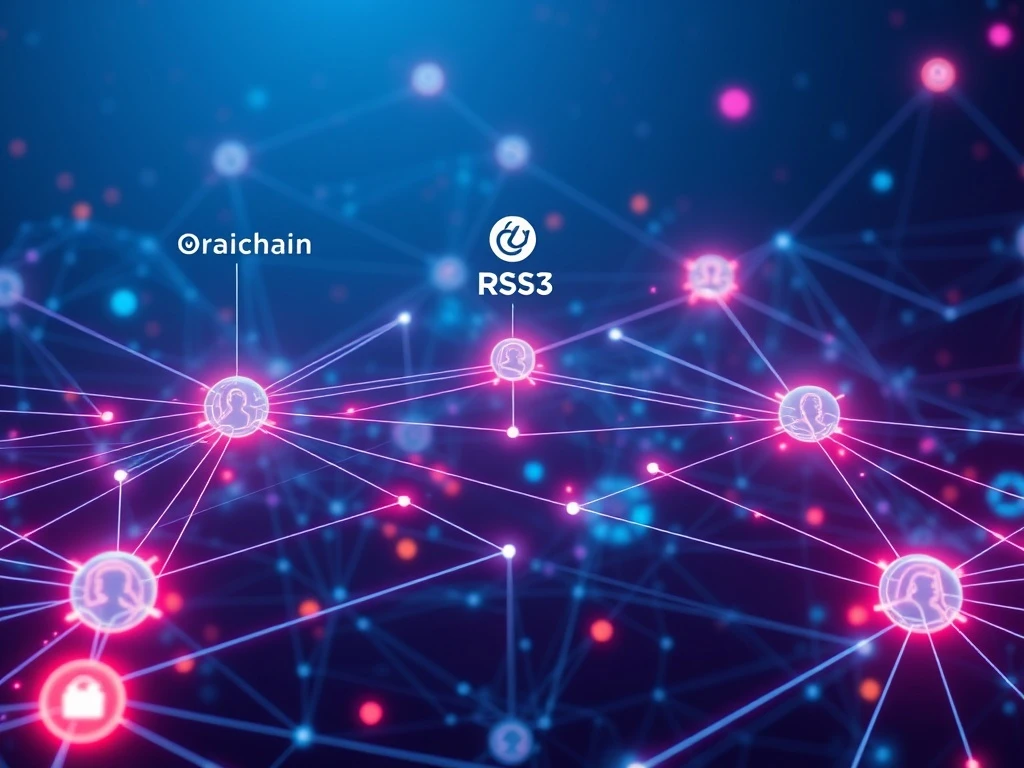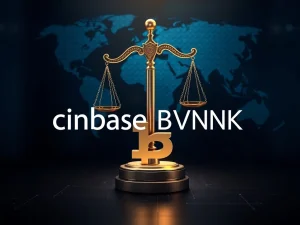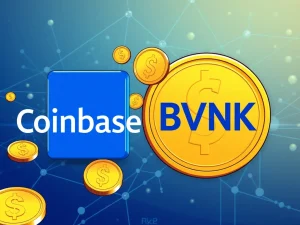Digital Identity: Revolutionary Frameworks from Oraichain, Pinlink, and RSS3 Unlocking Verifiable Assets by 2025

Imagine a world where your online presence isn’t just a collection of scattered profiles, but a unified, verifiable, and valuable asset you truly own. This isn’t a distant dream; it’s the imminent reality being built by pioneers like Oraichain, Pinlink, and RSS3. These groundbreaking projects are launching transformative frameworks designed to revolutionize how we perceive and manage our digital identity, moving us towards a future where your online persona is as robust and verifiable as your real-world credentials.
The Fragmented Reality of Current Digital Identity: Why Change is Crucial
For too long, our online lives have been defined by a fragmented and often insecure system of identity management. From social media logins to banking portals, our personal data is scattered across countless centralized databases, each a potential target for breaches and misuse. We lack true ownership and control over our digital selves, leading to a host of problems:
- Data Silos: Your reputation on one platform doesn’t carry over to another.
- Lack of Verifiability: It’s hard to cryptographically prove attributes like skills, certifications, or even age without exposing sensitive data.
- Privacy Concerns: Centralized entities control vast amounts of your personal information, making you vulnerable to censorship or data exploitation.
- Limited Portability: Moving your online persona from one service to another is often cumbersome, if not impossible.
The decentralized web, or Web3, offers a powerful antidote to these issues. By leveraging blockchain technology, Web3 aims to empower individuals with self-sovereign identity – an identity that is owned and controlled by the user, not by a corporation. However, building a truly comprehensive and functional digital identity in Web3 requires more than just a wallet address. It demands frameworks that can integrate verifiable attributes, economic stakes, and social engagement into a cohesive, user-owned asset. This is precisely where the collaborative efforts of Oraichain, Pinlink, and RSS3 come into play, poised to redefine our online existence by July 2025.
Oraichain’s AI Oracle: Crafting Verifiable Credentials for a Trustworthy Web3
At the forefront of building a verifiable Web3 identity is Oraichain, an AI-powered oracle and blockchain platform. Oraichain’s innovative approach centers on verifiable credentials and biometric verification, leveraging its unique AI oracle technology to enable secure attestations of various attributes without compromising sensitive data. Think of it as a digital notary, but one that operates on a decentralized network and uses artificial intelligence to ensure the authenticity of information.
How does Oraichain achieve this?
- AI Oracle Technology: Oraichain’s AI oracles can connect real-world data and traditional systems with blockchain networks. This allows for the secure and verifiable attestation of off-chain information, such as educational degrees, professional certifications, or even physical traits.
- Biometric Verification: Early use cases, like Oraichain’s ‘face authentication’ system, demonstrate how users can verify their identities through cryptographic proofs while maintaining privacy. Instead of sharing your actual facial data, the system generates a cryptographic proof that you are indeed the person you claim to be, based on your biometrics. This proof is then recorded on-chain.
- Privacy-Preserving Attestations: The core principle is zero-knowledge proofs (ZKPs), which allow one party to prove to another that a statement is true, without revealing any information beyond the validity of the statement itself. This means you can prove you are over 18 without revealing your exact birthdate, or that you have a specific certification without showing the certificate itself.
This method creates a robust foundation for on-chain reputations that are both trustworthy and privacy-preserving. With Oraichain, your skills, certifications, and even physical traits can become verifiable components of your digital identity, building a reputation that is both secure and portable across decentralized applications.
Pinlink’s DePIN Integration: Bridging Digital Identity with Real-World Value
While Oraichain focuses on verifiable attributes, Pinlink takes a crucial step further by bridging digital identities with tangible real-world value. Pinlink achieves this by tokenizing infrastructure assets within Decentralized Physical Infrastructure Networks (DePIN). DePIN refers to blockchain protocols that incentivize individuals and communities to build and maintain real-world infrastructure, such as wireless networks, energy grids, or data storage solutions.
Here’s how Pinlink integrates this into your identity:
- Tokenizing Infrastructure Assets: Pinlink allows users to hold shares or ownership stakes in these decentralized physical infrastructure networks. For example, if you own and operate an edge computing node or contribute to a decentralized IoT device network, Pinlink can tokenize your contribution and ownership.
- Capital-Backed Identity Component: By holding these tokenized assets, users gain a capital-backed component to their digital identity. This isn’t just a badge; it’s a verifiable proof of your direct participation and investment in the decentralized economy’s foundational layers.
- Unlocking New Opportunities: This integration allows individuals to showcase their active participation, potentially unlocking access to financial services (like collateralized loans against your DePIN assets) or governance rights tied directly to the infrastructure you support. Your identity evolves beyond mere online presence to reflect your economic contributions to the decentralized world.
Pinlink essentially makes your real-world contributions and economic stakes a fundamental, verifiable part of your online persona, adding a layer of tangible value to your digital self.
RSS3’s Identity Graph: Unifying Your Social and Content Footprint
Completing the trifecta, RSS3 addresses the crucial social and content dimensions of digital identity. In the current Web2 landscape, our social interactions, blog posts, and creative content are fragmented across numerous platforms, each controlled by a different corporation. RSS3 aims to change this by aggregating decentralized activities into a unified identity graph, giving users true ownership and control over their digital footprint.
How RSS3 transforms your social identity:
- Aggregating Decentralized Activities: RSS3 acts as an open information layer that indexes and aggregates all your decentralized activities. This includes your blog posts published on Web3 blogging platforms, your contributions to Decentralized Autonomous Organizations (DAOs), your NFTs, and your social interactions across various decentralized applications.
- Unified Identity Graph: All this aggregated data is then compiled into a unified, self-sovereign profile. Instead of your Twitter profile being separate from your Mirror.xyz blog and your DAO voting history, RSS3 brings them together into one coherent, portable identity graph.
- Seamless Portability: Unlike traditional platforms that fragment user data and lock you into their ecosystem, RSS3 ensures ownership of your digital presence. This allows for seamless portability of your entire social and content history across different Web3 ecosystems. You can take your reputation, your content, and your social graph with you, empowering true digital freedom.
By bringing together your social engagement and content creation, RSS3 ensures that your online persona is not just verifiable and economically backed, but also socially rich and truly owned by you.
The Power of Verifiable Composable Assets: A New Era for Digital Identity
Collectively, Oraichain, Pinlink, and RSS3 are not just building individual components; they are constructing a comprehensive framework where digital identity reflects verified attributes, economic stakes, and social engagement. This leads to the concept of ‘verifiable composable assets’ – an identity that is dynamic, modular, and built from various, independently verifiable components that you control.
What does this mean for you?
- A Holistic Digital Self: Your identity is no longer a static wallet address but a rich tapestry woven from your skills (verified by Oraichain), your real-world contributions (backed by Pinlink), and your social interactions (unified by RSS3).
- Unlocking New Possibilities: Imagine applying for a decentralized loan where your creditworthiness is assessed not just by your on-chain financial history, but also by your verifiable educational background and your active contributions to a DePIN project. Or applying for a job where your social reputation and past project contributions are instantly verifiable and portable.
- True Ownership and Control: You decide which pieces of your identity to share, with whom, and for what purpose. This level of granular control over your personal data is unprecedented in the digital age.
This combined effort is creating a new paradigm for digital interaction, where trust is established through verifiable proofs rather than reliance on centralized intermediaries. The vision for July 2025 is a world where these frameworks are not just concepts, but functional layers enabling a more secure, private, and economically vibrant Web3.
Benefits of This Transformative Shift
The implications of this shift towards verifiable, composable digital identities are profound, offering numerous benefits for individuals, businesses, and the broader Web3 ecosystem:
- Enhanced Privacy and Security: By using zero-knowledge proofs and decentralized storage, sensitive personal data can remain private while still being verifiable. This significantly reduces the risk of data breaches and identity theft.
- True Data Ownership: Users gain unprecedented control over their personal information. They can selectively reveal attributes, revoke access, and ensure their data isn’t exploited by third parties.
- Access to New Opportunities: A rich, verifiable digital identity can unlock access to decentralized finance (DeFi) services, governance participation in DAOs, new employment opportunities, and personalized services tailored to verified attributes.
- Streamlined Verification Processes: For businesses and service providers, verifying user credentials becomes faster, more reliable, and less costly, leading to smoother onboarding and reduced fraud.
- Increased Web3 Adoption: A robust and user-friendly identity layer is crucial for mainstream adoption of Web3. By making digital interactions more trustworthy and empowering, these frameworks pave the way for a broader user base.
Navigating the Road Ahead: Challenges and Considerations
While the promise of these frameworks is immense, significant challenges remain on the path to widespread adoption:
- Interoperability and Standardization: Each project operates within distinct technical ecosystems. Achieving seamless interoperability and establishing common standards across different blockchain networks and identity protocols is crucial for a truly unified Web3 identity.
- Regulatory Clarity: The legal and regulatory landscape for decentralized identities and tokenized assets is still evolving. Lack of clear guidelines could hinder scalability and adoption, especially in traditional sectors like finance and education.
- Risks of Identity Data Misuse: Even with privacy-preserving technologies, the aggregation of so much personal data, even if controlled by the user, poses risks if not managed responsibly. User education on best practices for managing their self-sovereign identity is vital.
- User Experience and Education: For mainstream users, understanding and managing complex cryptographic keys, verifiable credentials, and decentralized applications can be daunting. Intuitive interfaces and extensive educational resources are necessary for mass adoption.
- Scalability: As the number of users and identity components grows, the underlying blockchain infrastructure must be able to handle the increased transaction volume and data storage efficiently.
Future Implications and Actionable Insights
The broader implications of this trend extend far beyond mere identity management. A robust, verifiable, and composable digital identity can accelerate Web3 adoption in numerous sectors:
- Finance: Enhanced KYC/AML compliance with privacy, collateralized lending based on verifiable reputation, and personalized financial products.
- Education: Verifiable academic credentials, lifelong learning records, and portable skill certifications that employers can trust instantly.
- Employment Verification: Decentralized resumes, verifiable work history, and skill attestations, revolutionizing hiring processes and talent discovery.
- Healthcare: Secure and private management of medical records, enabling patients to control access to their health data.
For individuals, the actionable insight is clear: start exploring these technologies. Understand the concepts of self-sovereign identity, verifiable credentials, and the potential of DePIN. For developers and businesses, the opportunity lies in building applications and services that leverage these new identity frameworks, creating more secure, private, and user-centric experiences.
A New Dawn for Digital Identity
The combined efforts of Oraichain, Pinlink, and RSS3 mark a pivotal moment in the evolution of our online lives. By transforming digital identity from a static wallet address into a dynamic, verifiable, and composable asset, they are not just fixing existing problems but are unlocking a future where our online personas are truly our own. This revolutionary shift promises enhanced privacy, greater control, and unprecedented opportunities in the decentralized world. While challenges remain, the foundational frameworks are being laid, paving the way for a more empowered and trustworthy digital future by 2025 and beyond.
Frequently Asked Questions (FAQs)
What is a “verifiable composable asset” in the context of digital identity?
A “verifiable composable asset” refers to a digital identity that is built from various modular components, each of which can be cryptographically verified for authenticity. These components can include verified personal attributes (like age or certifications), economic stakes (like ownership in decentralized networks), and social engagement data. “Composable” means these pieces can be combined and recombined by the user to present different facets of their identity for specific interactions, always remaining under the user’s control.
How does Oraichain contribute to secure digital identity?
Oraichain contributes by providing a framework for verifiable credentials and biometric verification, powered by its AI oracle technology. It allows users to cryptographically prove attributes (e.g., skills, certifications, or even physical traits) without revealing the underlying sensitive data, using privacy-preserving techniques like zero-knowledge proofs. This creates a foundation for trustworthy and private on-chain reputations.
What role does Pinlink play in connecting digital identity to real-world value?
Pinlink bridges digital identities with tangible real-world value by enabling the tokenization of infrastructure assets within Decentralized Physical Infrastructure Networks (DePIN). Users who hold shares in DePINs (like edge computing nodes or IoT devices) gain a capital-backed identity component, showcasing their direct participation and investment in the decentralized economy. This can unlock access to financial services or governance rights tied to their real-world contributions.
How does RSS3 enhance social connectivity for digital identities?
RSS3 enhances social connectivity by aggregating decentralized activities into a unified identity graph. It collects and indexes a user’s content (e.g., blog posts), DAO contributions, and social interactions across various Web3 platforms. This creates a portable, self-sovereign profile that unifies a user’s digital presence, ensuring ownership and seamless portability across different ecosystems, unlike fragmented traditional platforms.
What are the main challenges to widespread adoption of these new identity frameworks?
Key challenges include achieving seamless interoperability and standardization across different blockchain networks and identity protocols, navigating evolving regulatory landscapes for decentralized identities, mitigating risks of identity data misuse (even with privacy tech), and ensuring a user-friendly experience to facilitate mainstream adoption. Scalability of underlying blockchain infrastructure is also a significant consideration.
Why is owning your digital identity important?
Owning your digital identity is crucial because it empowers you with control over your personal data, enhances your privacy and security, and prevents centralized entities from exploiting or censoring your online presence. It allows for selective disclosure of information, enables true portability of your reputation and data across platforms, and unlocks new economic and social opportunities in the decentralized web, fostering a more equitable and secure digital future.







